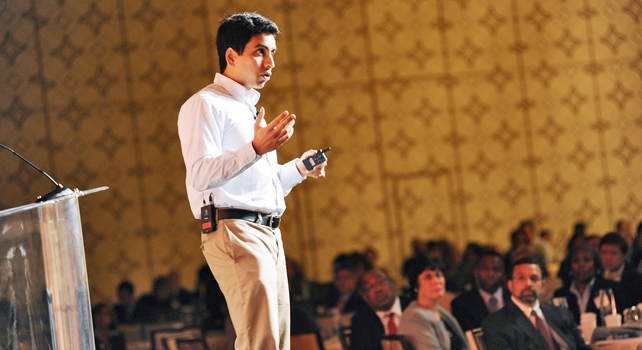Inside the online education juggernaut’s mission to make their free lessons available in more than a dozen languages.

Khan Academy, one of the world’s most popular educational sites, has a problem. People around the world want to learn online. However, the majority of world Internet users aren’t fluent English speakers. For Khan Academy, the answer is obvious: Translate content, using the Internet as its translators. Quickly.
Many American high school and college student–as well as many adult, non-students–are already familiar with Khan Academy. The site, founded by former hedge fund analyst Salman Khan, hosts thousands of free, high-quality educational videos. Though most of the site’s content focuses on mathematics, hard sciences, and computing, recent videos have begun covering the liberal arts as well.
The donation-funded non-profit has spent the past few years systematically porting their lectures and tests into over 16 foreign languages. Volunteer workers crowdsourced from the Internet work closely with Khan Academy supervisors to create subtitles for lectures, along with voiceovers for select videos. According to Khan Academy Dean of Translations Bilal Musharraf (Yes, that’s his official title; Musharraf is the son of former Pakistani Prime Minister Pervez Musharraf), the organization crowdsources translators through Universal Subtitles‘ Amara platform, which recruits volunteers worldwide to write foreign language and closed-caption translations. Other Universal Subtitles clients include TED and PBS.
Translated content availability for Khan Academy varies wildly from language to language. Estonian is the most frequently subtitled language, with over 500 videos available, followed by Polish and Spanish. Dubbed content is available in 16 languages including Bangla, Hebrew, Malayalam, and Swahili. Musharraf tells Fast Company that each language has an official “Language Advocate” whose job is to review translations for accuracy and fluency. Language Advocates review both subtitles for Khan Academy videos and audio dubs.
Creating subtitled Khan Academy videos doesn’t just boost the website’s profile in non-Anglophone markets. Subtitles also help Khan Academy work SEO magic and lure in new viewers via Google and other search engines. The not-so-dirty secret is that video transcripts are fully searchable and can help make Khan Academy’s content easier to discover.
While any Khan Academy user can subtitle videos, dubbing requires a stricter approval process. Potential voice-over volunteers undergo strict vetting by the non-profit; Khan places great importance on hand-holding voiceover artists and close supervision to guarantee accuracy and a consistent tone. In most cases, Khan Academy tries to use one voiceover person for each foreign language. Translators are expected to contribute a significant time investment; Khan Academy’s Bangla project, for instance, requires at least 20 hours a week of volunteering.
Khan Academy’s subtitle project began at the end of 2010 and is ongoing. Current language priorities, according to Musharraf, are Spanish, Portuguese, and Bengali. In the longer term, Khan Academy also plans to add original foreign language content–lectures and chats conducted from start to finish in non-English languages with no translation involved. Volunteers for translation are still being accepted.









Translating the practice exercises on Khan Academy would also be great for learners around the world. After all, watching the videos helps to gain an initial understanding of a concept, but practicing problems enables the concept to be truly grasped. Practice makes perfect.
Joe Wagner
Founder, Backpack TV
I would like to work for Khan Academy. I have done translation and original work in Bangladesh independently and for The Asiatic Society. I have adequate time at my disposal.
Mr. Ahmed,
You may apply to be a translator at Khan Academy at their website http://www.khanacademy.org/contribute
Best of Luck.